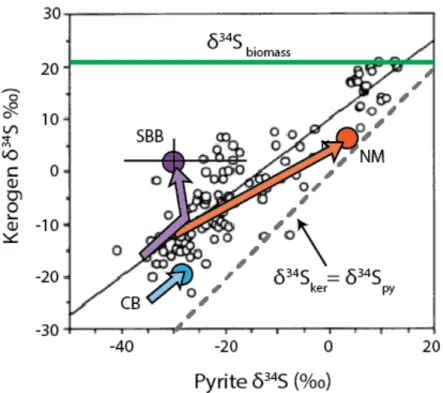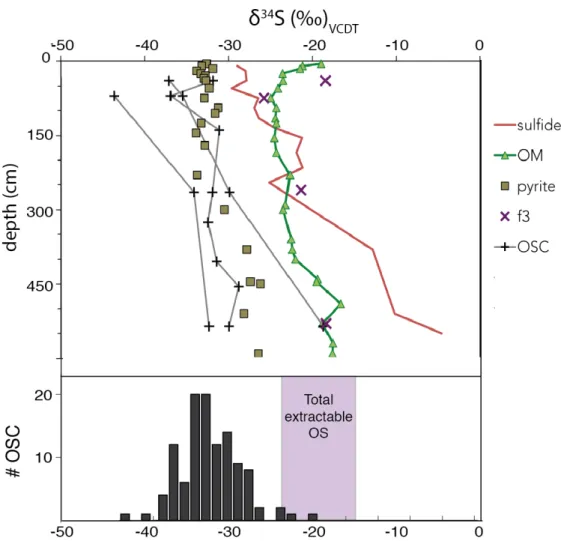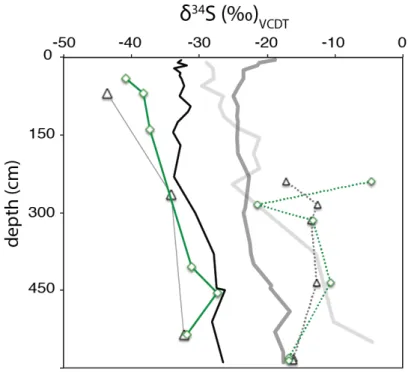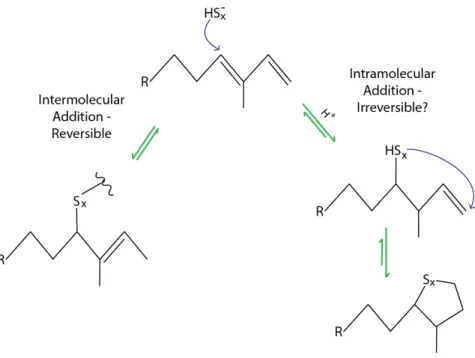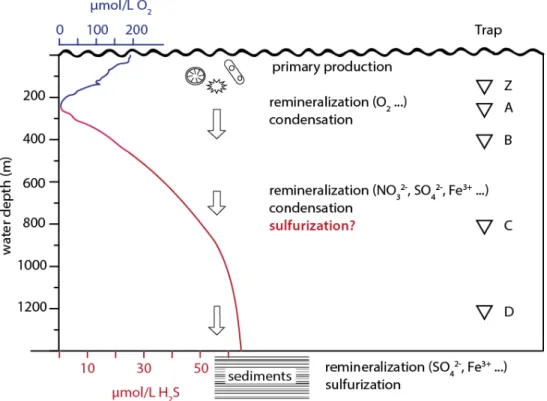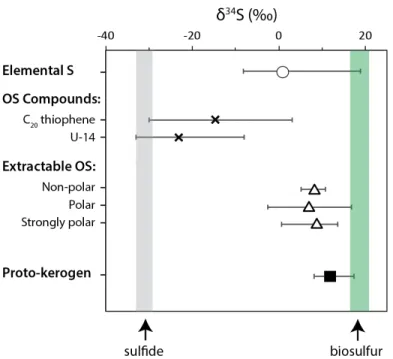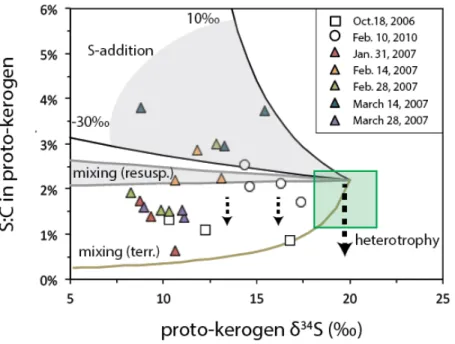All organosulfur compounds are more 34S-depleted than bulk extractable OS pools and sulphide pore water. Carbohydrate preservation by sulphurisation in a Jurassic euxinic shelf sea: a review of the Blackstone Band TOC cycle in the Kimmeridge Clay Formation, UK.
THE SULFUR ISOTOPIC COMPOSITIONS OF INDIVIDUAL ORGANIC COMPOUNDS FROM CARIACO BASIN
INTRODUCTION
We use a newly developed method of compound-specific sulfur isotope analysis (Amrani et al., 2009) to obtain δ34S values for individual, GC-susceptible organosulfur compounds from Cariaco Basin sediments. However, because OSC forms at different rates and during different stages of early diagenesis (Sinninghe Damsté et al., 2007; Vairavamurthy et al., 1994; Vairavamurthy and Mopper, 1987; Werne et al., 2008), bulk organic sulfur potentially represents a mixture of OSC with different δ34S values.
SITE BACKGROUND
Other available data for this core include concentrations of organic and inorganic carbon, molybdenum, iron and aluminum (Lyons et al., 2003), and major biomarker distributions (Werne et al., 2000b). Organosulfur compounds were also observed in the extractable lipid fraction below 240 cm (Werne et al., 2000).
METHODS AND INSTRUMENTATION
- Compound-specific δ 34 S analysis by GC-ICPMS The sulfur-isotopic compositions of individual GC-amenable organic compounds from
- Analysis of bulk organic fractions by ICPMS Aliquots of each fraction (F1, F2, F3) of the solvent extract were dried and then oxidized
Accuracy was established by repeated analyzes of external standard mixtures containing three to six OSCs with known δ34S values. With this adjustment, both sensitivity and δ34S values shifted systematically (by nearly 10‰ in the latter case) as the GC oven was increased from 80° to 300°C.
RESULTS AND DISCUSSION
- OSC identification and abundance A consistent suite of organosulfur compounds was observed by GC-MS-SCD and GC-
- OSC sulfur-isotopic compositions Several compounds have consistently lower δ 34 S values than pyrite and represent the
- Isotope effects during organic matter sulfurization The δ 34 S profiles for individual OSC in Cariaco Basin reflect a combination of the δ 34 S
A minor component of pyrite in sediments of the Cariaco Basin is diagenetic, forming in a diffusion-controlled regime in sediments in which sulfide δ34S values increase with depth (Werne et al., 2003). Werne et al. 2000) has convincingly demonstrated the diagenetic production of the triterpenoid thiane based on the degree of conversion of precursor molecules.
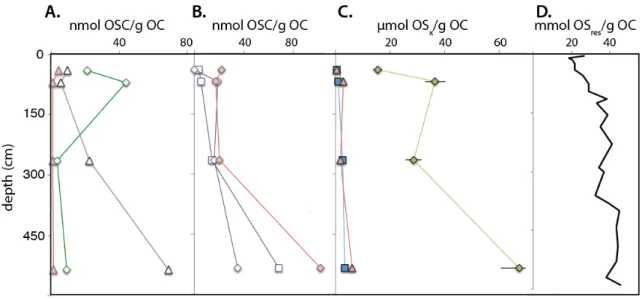
CONCLUSIONS
Origin and diagenetic transformations of C25 and C30 highly branched isoprenoid sulfur compounds - further evidence for the formation of organically bound sulfur during early diagenesis. Reduced sulfur in euxinic sediments of the Cariaco Basin: sulfur isotope limits the formation of organic sulfur.
RAPID ORGANIC MATTER SULFURIZATION IN THE WATER COLUMN OF CARIACO BASIN
METHODS
A time series study was started in Cariaco Basin in 1995 (Muller-Karger et al., 2001) and used a set of automatic sediment traps positioned at different depths in the water. We refer to the residual sulfur, which is not soluble in organic solvent, water or nitric acid, as 'proto-kerogen' for consistency with Raven et al.
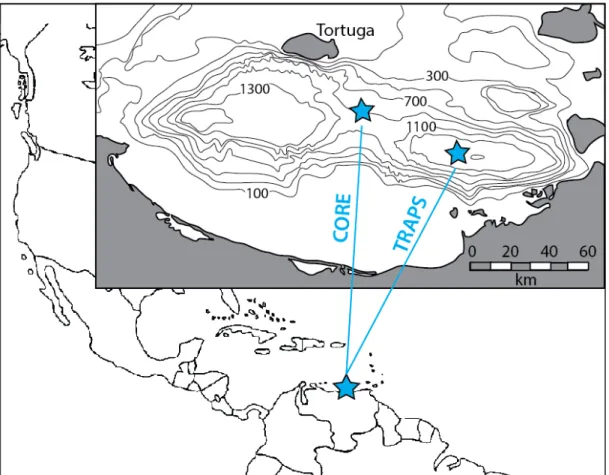
RESULTS
- Carbon and sulfur in particulate proto-kerogen Table 1. Carbon and sulfur data for sinking particles
The observed δ34S values for S0, two individual OS compounds, extractable OS fractions and proto-kerogen are summarized in Figure 3. We are also able to measure δ34S values for the most abundant GC-friendly organosulfur compound in the polarity fraction of intermediate of 8 samples (Table 2).
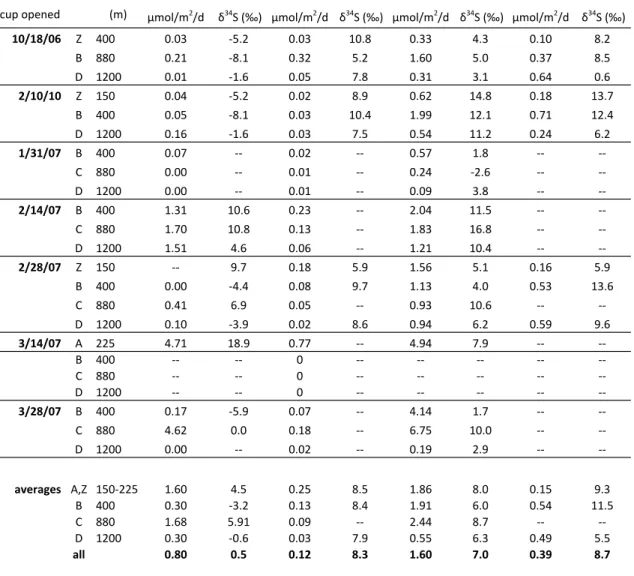
DISCUSSION
- Hydrography and primary productivity during sampling Water column profiles of potential density (σ θ ) and chlorophyll-a from the CARIACO
- Correlated δ 34 S variability in winter 2007
- Potential influence of mixing with terrigenous and resuspended sediment Proto-kerogen, S 0 , and C 20 thiophene δ 34 S data for February 2010 and October 2006 fall
- Water column sources of organic S to sedimentary proto-kerogen Table 4: Estimated contribution of water column sulfurization to sedimentary proto-
- Significance of rapid OM sulfurization for carbon burial The quantitative significance of water column-derived, abiogenic OS will depend on the
- The S-isotope composition of rapidly sulfurized OM The correlated S-isotopic compositions of S 0 , C 20 thiophene, and proto-kerogen indicate
Fresh biomass sinking from the photic zone of the ocean will undergo heterotrophic degradation, condensation reactions and mixing with other materials (Eglinton et al., 1994), each of which changes the S:C ratio and δ34S value of protokerogen. 5 as a mixing field between biomass and proto-kerogen in surface sediments of Cariaco Basin (upper 100 cm of ODP Core 1002B sediments, Werne et al., 2003). Polysulfide δ34S values should therefore reflect mixing between particulate S0 and water column bisulfide, which has a δ34S value consistently close to -30‰ (Li et al., 2010).
Sediment proto-kerogen δ13C values (-20 to -18‰, Fry et al., 1991) correlate well with particles, suggesting that this OM must be derived from the water column. We use the concentration of protokerogen S at 10 cm depth in sediments of the Cariaco Basin, 95 µmol S/g, as an estimate of the total accumulation of abiogenic OS from the water column and shallow (0-10 cm) sedimentary processes (Raven et al ., 2015; Aycard et al., 2003). Sedimentary sulfurization on this time scale (about 6000 years) in Cariaco Basin was described in Aycard et al. 2015) for individually extractable organic compounds.
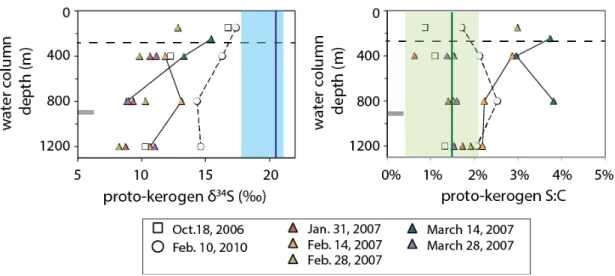
PROPOSED ROLE OF ORGANIC SULFUR
Apparent rates of microbial sulfate reduction (MSR) A fundamental control on the sedimentary sulfur cycle is the rate of microbial sulfate
In the next section, we constrain the rates of net and gross MSR in our cores based on changes in the abundance and isotopic composition of sedimentary sulfur pools, reducible iron (FeR), and DIC. In the absence of O2, sulfide oxidation may be accompanied by the reduction of ferric iron, manganese oxides, or nitrate. Nitrate concentrations were observed to drop to zero within a few cm of the surface throughout the Santa Barbara Basin (Reimers et al., 1996), so Fe(III)-bearing phases likely represent the primary electron acceptors for subzone sulfide reoxidation 1.
In the gravity core, the abundance of FeR declines at an even slower rate (10 nmol/cm3/yr) and can only be calculated. The low MSR rate we derive would not generate any observable curvature in the DIC concentration profile, since DIC will diffuse upward from the SMTZ (assuming a diffusion constant of ~1 x 10-5 cm2/sec) at approximately 45 μmol/cm2/year. Although the limitation of OM in the presence of 4% wt.% TOC may seem paradoxical, it may instead speak to the importance of OM stabilization near the sediment-water interface.
Pyrite Formation in Santa Barbara Basin Pyrite in Santa Barbara Basin sediments appears to form most rapidly near the sediment-
What additional processes could explain the persistent 34S enrichment of porewater sulfide relative to pyrite, proto-kerogen S, and S0. Pore water ∑H2S and proto-kerogen have very similar δ34S values in the upper 35 cm of the gravity core (within ∼2‰). The S isotope composition of proto-kerogen partially follows that of pore water ∑H2S throughout the deeper sediments and in the ODP core.
In the Santa Barbara Basin, equilibration can drive particularly large δ34S discrepancies between pyrite and proto-kerogen because proto-kerogen S is highly abundant while the rate of ∑H2S production is low. Essentially, we suggest that sulfide δ34S values in shallow sediments are buffered by local exchange with OS, including polar extractable OS and part of the larger proto-kerogen pool. These sediments are also characterized by peak concentrations of FeR, TOC and proto-kerogen OS and relatively 34S-enriched pyrite and S0.
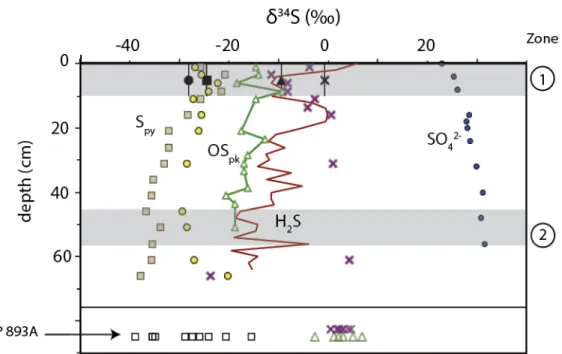
The generation of sedimentary sulfur isotope records Pyrite δ 34 S values are often interpreted in terms of their formation under idealized closed-
1979) Early oxidation of organic matter in pelagic sediments of the eastern equatorial Atlantic: suboxic diagenesis. Stable isotope studies of carbon, nitrogen and sulfur cycles in the Black Sea and the Cariaco Trench. Distribution of dissolved sulfide in the water column and sedimentary pore waters of the Santa Barbara Basin.
A steady-state model for sulfur isotope fractionation in bacterial reduction processes. 1990) Seasonal distribution and plume formation in the Santa Barbara Basin, California. 1996) Porewater pH and authigenic phases formed in the uppermost sediments of the Santa Barbara Basin. Evolutionary changes over the past 1000 years of reduced sulfur and organic carbon phases in buried sediments of the Santa Barbara Basin, California.
SULFUR ISOTOPE EXCHANGE BETWEEN ORGANIC MATTER AND POLYSULFIDES
Inorganic S burial as pyrite has been the focus of most work in the field and is generally treated as representing the total sink of reduced sedimentary S (Berner, 1987; Canfield, 2005; Halevy et al., 2012). At the same time, both pyrite and buried organic matter (OM) can be major sinks for sedimentary S (Mossman et al., 1991; Eglinton et al., 1994), and they can respond differently to environmental conditions. Sulfur in biomass is predominantly in the forms of cysteine and methionine in proteins, which are relatively valuable substrates for heterotrophs and can even be preferentially remineralized during OM diagenesis (Van Mooy et al., 2002; Matrai et al., 1989).
Because pore water sulfide typically becomes increasingly 34S enriched with depth, later-forming OS would have higher δ34S values than faster-forming pyrite (Hartgers et al., 1997; Werne et al., 2003). isotope exchange between OS and sulfide was previously proposed to explain δ34S profiles from the Namibian shelf (Dale et al., 2009). Amrani et al., 2008), and thiol-disulfide exchange reactions are well known from enzyme biochemistry (Gilbert, 1995).
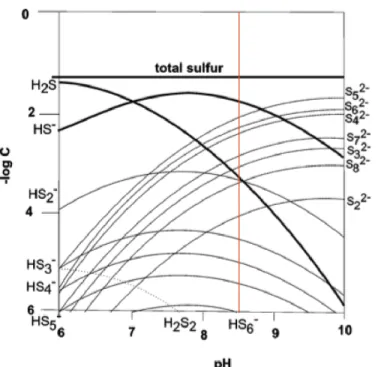
The polysulfide S0 fraction consists primarily of zero-valent S from dissociated polysulfides, but also includes 'neutral S0.' Sulfur in the 'aqueous' pool should be in the form of acid-soluble organic substances (humic acids, amino acids) and/or ionic salts (sulphate, sulphite, thiosulphate). Therefore, we expect that about 60% of polysulfide S atoms are recovered in the polysulfide S0 pool (along with nanoparticles and α-S0) and 40% addn. In all samples collected between days 1 and 26, measured sulfide δ34S values in the polysulfide solution were consistently σ) lower than neutral S0 δ34S values, although absolute δ34S values for both pools changed steadily due to gradual 34S0 (s) dissolution.
Circles and squares indicate δ34S values for neutral S0 and reactive Zn sulfide, respectively, as defined in the text. We noticed that less cysteine was found in the total fraction than in the aqueous fraction. Humic acid was found mainly in the aqueous fraction, but about 10% of humic acid S was hydrolyzed in 0.5 N HCl and recovered as S0 polysulfide.
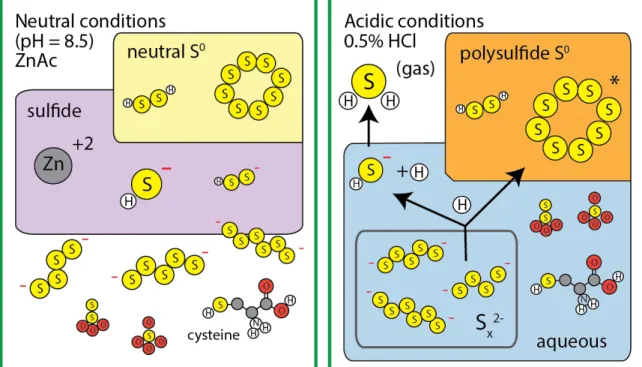
Sampling and analytical methods
Solvent-extracted sediments were washed with MQ water and leached with 1M nitric acid at 20°C for ten days (Schimmelmann and Kastner, 1993) to oxidize pyrite and hydrolyzable organic matter. The remaining sulfur, which is not soluble in organic solvent, water or nitric acid, is called 'proto-kerogen'. Proto-kerogen abundance and δ34S values were measured with a combustion element analyzer – isotope ratio mass spectrometry (EA-IRMS, a Carlo Erba NC 2500 EA connected to a Delta+ XL ThermoQuest via the Thermo Conflo III interface).
Proto-kerogen concentrations and δ34S data have estimated uncertainties based on standard replicates of ± 2.5% and ± 0.5‰, respectively. Oxidized samples of extractable OS and dissolved S groups were purified and analyzed for concentration and δ34S value according to the methods detailed in Chapters 3 and 4, which are based on Paris et al. Samples were injected into the plasma torch with a desolvating nebulizer (Aridus) and bracketed with known δ34S NaSO4 standards.
EXPERIMENTAL RESULTS AND DISCUSSION
- Polysulfides + model organic S compounds (experiment #1) Four different types of organic sulfur at concentrations of approximately 1.5 mM were
- Chemical reactivity of ∑S ≤0 and sedimentary OM (experiment #5) Methods for experiment #5 were identical to experiment #4 except that both solids and
The arrows in graph (a) highlight the change in the δ34S value of the organic reactant S before and after incubation. Cysteine – Cysteine is recovered in the aqueous fraction (Table 2), which is significantly more enriched in 34S after incubation, at 127‰ compared to an initial δ34S value of 5.6‰. Throughout, dashed vertical lines separate the early and late stages of the experiment, discussed in the text.
The change in the δ34S value of the aqueous fraction and the amount of S recovered in the polysulfide S0 fraction imply that between 25 and 44% of the cysteine is in the form of organic polysulfides during the first two hours of the experiment, with a δ34S value. value comparable to the polysulfide S0 fraction. Later in the experiment, S in the polysulfide S0 fraction would come mainly from Sn2- rather than cysteine polysulfide. In the shallow sediment incubations, this final isotopic composition of polysulfide S0 matches well with that of proto-kerogen S, consistent with ∑S≤0 and OS at or near equilibrium.
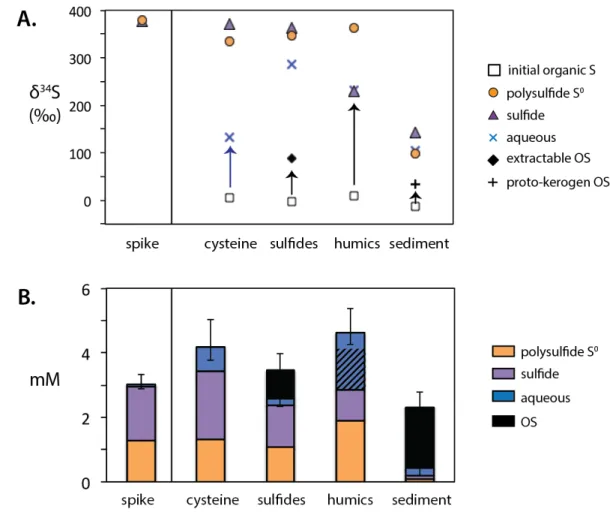
IMPLICATIONS FOR SEDIMENTARY δ 34 S RECORDS
- Interpreting δ 34 S records from Santa Barbara Basin In general, the results of experiments with sediments from Santa Barbara Basin confirm
Colored arrows indicate trends in contemporaneous pyrite and OM δ34S values with depth in three modern sites: Cariaco Basin (CB, Werne et al., 2003), Santa Barbara Basin (SBB, Bruchert et al., 1995) and the Namibian shelf (NM, Dale et al., 2009). 9 compares this global compilation with the evolution of proto-kerogen and pyrite δ34S values with sediment depth in three modern environments with different redox conditions. Sediments from the Santa Barbara Basin (Chapter 4) initially follow the global trend, with parallel increases in pyrite and OM δ34S values.
In sediments from the Namibian shelf, Dale and colleagues (2009) suggested that both pyrite and protokerogen exchange with ∑S≤0, producing similarly high δ34S values in both pools. In contrast to both of these sites, the δ34S values of pyrite and proto-kerogen in the Cariaco Basin start low and change relatively little in the upper 6 m of sediment. Sulfide-OS exchange may be an important mechanism affecting the distribution of OS and pyrite δ34S values worldwide.
